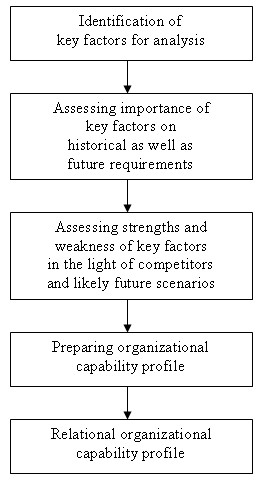The process of organizational analysis goes through certain sequence of activities. This process is undertaken so that the organization reaches at a point at which It can undertake strategic actions in the light of its strengths and weaknesses. For this purpose, the relevant information is collected both from internal as well as external sources. Generally, the organization’s strengths and weaknesses are measured in terms of its environment; otherwise, it is very difficult to suggest the degree to which a factor can be considered as strength or weakness. For adopting criteria in respect of these, the external information is quite helpful. For example, an organisation cannot say that its financial position is strong unless it is aware about its direct or other competitors’ financial position.
Thus, process of organizational a analysis will proceed through a sequence of activities as shown in figure below.

- Identification of Key Factors: Organizational analysis process starts with the identification of key factors that can be evaluated for determining strengths and weaknesses. The analysis should cover all aspects of the organization. However, what factors should be taken for consideration is a question, the answer of which may not be rigid and static. The answer will vary among organizations, and although a generalized list can be given, a real situation I would call for critical selection. These factors may be in the area of organization structure and management pattern, personnel, finance and accounting, marketing, manufacturing, research and development, etc.
- Identification of Importance of Factors: All the factors identified for the purpose of analysis may not have equal strategic importance; some are more important, some are less important. The relative importance of the factors depends on the nature of organisation and its environment. Their relative importance can be determined by finding out the contributions of each factor in the achievement of certain key results. The key result areas for the organisation can be defined on the basis of organisational objectives towards which total efforts are directed.
- Assessing Strengths and Weaknesses on Key Factors: Identification of key strategic factors may lead to the assessment of organisational strengths and weaknesses in respect of these factors. Organizational strength on any factor can be defined as the contribution made by the factor towards the achievement of the organizational objectives. Since objectives have hierarchy lower level objective contributes to higher level objective, a factor may not necessarily contribute directly to the achievement of overall objectives but may contribute indirectly by achieving a lower level objective. An organisational weakness on a factor can be defined as the negative contribution of the factor in achieving the organizational objectives. Another way for assessing strengths and weaknesses is to make a comparative analysis of these factors with those of the competitors. For the assessment of organisational strengths and weaknesses, some techniques financial analysis, key factor rating, and functional area profile and resource development matrix have been developed.
- Preparing organizational Capability Profile: On the basis of the assessment of organisational strengths and weaknesses, organisational capability profile is prepared which shows the various strong areas of the organisation. This profile can show the strengths or weaknesses in terms of degree, either in quantity like 1 to 5 for various factors or definition like very strong to average. However, when both strengths and weak- nesses are taken in the same profile, the positive numbers can be used for strength and negative numbers can be used for weakness if quantitative measurement is used.
- Relating Organisational Capability to Strategy: Technically speaking, this is not the part of the organisational analysis; however, organisational analysis is meaningless unless it provides a way to relating strengths to its strategy. In relating organisational strengths to strategy, the managers can proceed in two ways. First, they undertake activities which are consistent with their strategic strengths. Thus, rather than taking the various activities, they can concentrate on the limited number of activities. In fact, that organisation is more effective whose strategy fits its environment considering its strategic strengths than those who do otherwise. Second, managers can undertake activities which convert their weakness into strength. Such an action may provide synergistic advantages reducing thereby many disadvantages. Thus, many strategic actions can be taken to increase organisational strengths. The result is that over the long run. the strategy of the organisation fits its environment taking into account the strategic strengths.

